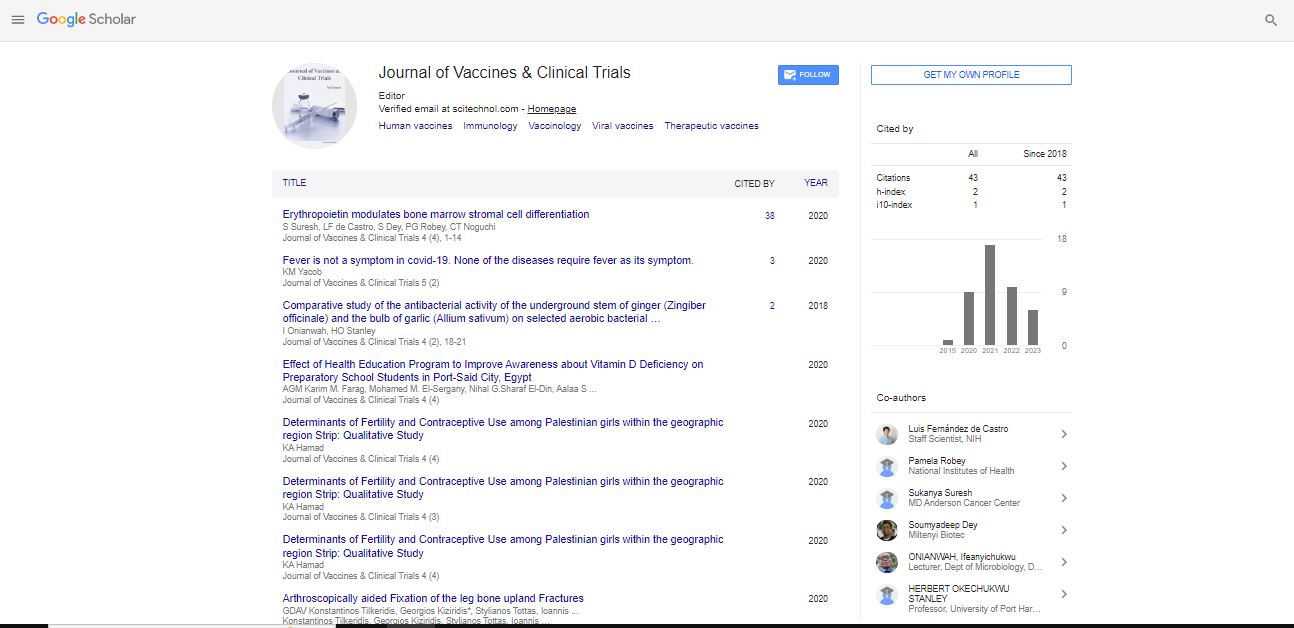Short Communication, Jou Of Vac Cli Tr Vol: 7 Issue: 1
Rabies a Preventable Viral Disease: Its Symptoms and Diagnosing
Kaster Benie*
1Department of Virology, University of New Haven, West Haven, USA
*Corresponding Author: Kaster Benie
Department of Virology, University of New Haven, West Haven, USA
E-mail: benkastie12@hotmail.com
Received date: 24 February, 2023, Manuscript No. JVCT-23-92731;
Editor assigned date: 28 February, 2023, PreQC No. JVCT-23-92731(PQ);
Reviewed date: 13 March, 2023, QCNo JVCT-23-92731;
Revised date: 21 March, 2023, Manuscript No. JVCT-23-92731 (R);
Published date: 30 March, 2023, DOI: 10.4172/JVCT.100061.
Citation: Benie K (2023) Rabies a Preventable Viral Disease: Its Symptoms and Diagnosing. Jou of Vac Cli Tr 7:1.
Description
Rabies is a viral disease that affects the central nervous system of mammals, including humans. It is typically transmitted through the bite of an infected animal, such as a dog or a bat. Once symptoms appear, the disease is almost always fatal. However, timely administration of a Post-Exposure Prophylaxis (PEP) can prevent the disease from progressing.
The rabies virus belongs to the Lyssavirus genus and is transmitted through the saliva of infected animals [1-3]. The virus targets the nervous system and can cause inflammation of the brain and spinal cord. The incubation period for the virus can vary from a few days to several years, depending on the location of the bite and the amount of virus that enters the body.
Rabies can be classified as either urban or sylvatic. Urban rabies is typically found in dogs and other domestic animals, while sylvatic rabies is found in wildlife, such as bats, foxes, and raccoons. In some cases, domestic animals can become infected with sylvatic rabies if they come into contact with infected wildlife.
Symptoms
The symptoms of rabies can vary depending on the stage of the disease. The initial symptoms can include fever, headache, and fatigue. As the disease progresses, symptoms such as anxiety, confusion, and agitation may appear. In the final stages of the disease, the individual may experience seizures, paralysis, and difficulty swallowing.
Diagnosing rabies can be challenging, as the symptoms can mimic those of other diseases. If an individual has been bitten by an animal, it is important to seek medical attention immediately [4-6]. A doctor can perform a physical examination and order diagnostic tests, such as a skin biopsy or a spinal tap, to confirm the presence of the virus.
Treatment
The treatment for rabies involves a combination of PEP and supportive care. PEP consists of a series of injections of rabies immune globulin and the rabies vaccine. In some cases, treatment may also involve antiviral medications and other supportive measures, such as intravenous fluids and respiratory support.
Preventing rabies involves a combination of vaccination and avoiding contact with infected animals [7-10]. Vaccination is recommended for individuals who are at high risk of exposure to the virus, such as veterinarians, animal control workers, and travelers to areas where rabies is endemic. In addition, individuals should avoid contact with stray animals and wildlife, and should seek medical attention immediately if they are bitten or scratched by an animal.
Conclusion
Rabies is a serious and potentially fatal disease that can be prevented through vaccination and avoiding contact with infected animals. If a person is bitten or scratched by an animal, it is important to seek medical attention immediately to prevent the disease from progressing. With prompt diagnosis and treatment, the chances of a full recovery are greatly improved.
Rabies is a viral disease caused by the RABV virus. When the virus enters the body, it travels to the brain and other parts of the nervous system, causing inflammation and damage to the tissues. Rabies can cause a wide range of symptoms, including flu-like symptoms, fever, muscle weakness, and seizures. As the disease progresses, it can lead to more severe symptoms, such as hallucinations, paralysis, and difficulty swallowing water. In some cases, rabies can also cause blockage of airways, seizures, exhaustion, or widespread paralysis, which can be fatal. It's important to seek medical attention immediately if a person think they may have been exposed to rabies, as early treatment can prevent the disease from progressing.
References
- Thiravat H, Gabriella U, Supaporn W, Witaya S, Shanop S, et al. Human rabies: Neuropath genesis, diagnosis, and management. Lancet Neurol 12(5): 498-513.
- Jackson AC. Rabies: A medical perspective. 37(2): 569-580.
- Christina L, John DC (2020) Epidemiology of rabies and current US vaccine guidelines. R I Med J (2013) 103: 51-53.
- Kirstyn B, Nardus M (2018) Rabies Virus. Trends Microbiol 26: 886-887.
- Naohide T (2008) Rabies: A preventable but incurable disease. J Infect Chemother 14: 8-14.
- Céline M, Andre C, Bassirou B, Angélique A, Charles B, et al. (2021) Dog rabies control in West and Central Africa: A review. Acta Trop 224: 105459.
- Benjamin NHS, Benjamin Ng WL, Wong SN, Shanthi V (2021) A retrospective analysis of emerging rabies: A neglected tropical disease in Sarawak, Malaysia. J R Coll Physicians Edinb 51(2): 133-139.
- Luis Fernando V, Katherine V, Nathalia Marcela P, Diego Andrés L, Daniela Á, et al. (2022) Use of antibiotics in patients who were attacked by animals that can transmit rabies. Zoonoses Public Health 69:978-986.
- Wei L, Pavan M (2015) Facial dog attack injuries. Indian J Surg 77:55-8.
- Ye F, Jihong M, Sheng S, Lijuan C, Zhanying K, et al. (2021) Epidemiology of Animal Rabies-China, 2010-2020. China CDC Wkly 3: 815-818.
 Spanish
Spanish  Chinese
Chinese  Russian
Russian  German
German  French
French  Japanese
Japanese  Portuguese
Portuguese  Hindi
Hindi 